Research on an IoT-Based Smart Air Conditioner System for Efficiency
VerifiedAdded on 2022/10/17
|17
|4702
|11
Report
AI Summary
This report, submitted by a student and available on Desklib, investigates the application of Internet of Things (IoT) technology to enhance the energy efficiency of air conditioning systems. The research explores the integration of IoT to create smart air conditioners, focusing on cognitive IoT factors, remote control access, HVAC control, and IoT-based monitoring and control systems. The report reviews existing literature, analyzes methodologies including deductive approaches, and discusses how IoT can optimize air conditioner performance, reduce electricity consumption, and provide user comfort. The study highlights the potential of smart technologies in addressing energy consumption issues and provides insights into the design and implementation of energy-efficient air conditioning systems.
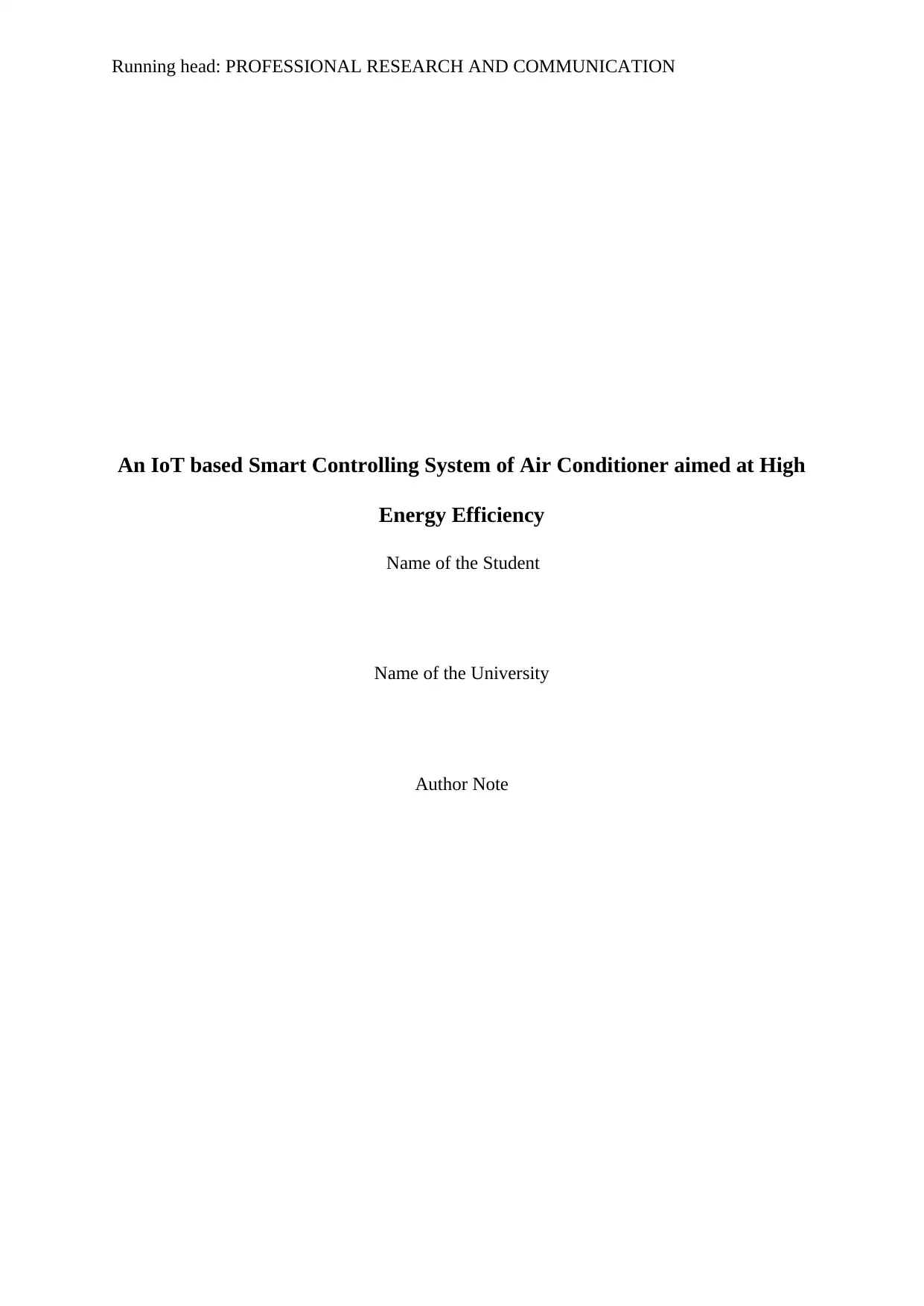
Running head: PROFESSIONAL RESEARCH AND COMMUNICATION
An IoT based Smart Controlling System of Air Conditioner aimed at High
Energy Efficiency
Name of the Student
Name of the University
Author Note
An IoT based Smart Controlling System of Air Conditioner aimed at High
Energy Efficiency
Name of the Student
Name of the University
Author Note
Paraphrase This Document
Need a fresh take? Get an instant paraphrase of this document with our AI Paraphraser
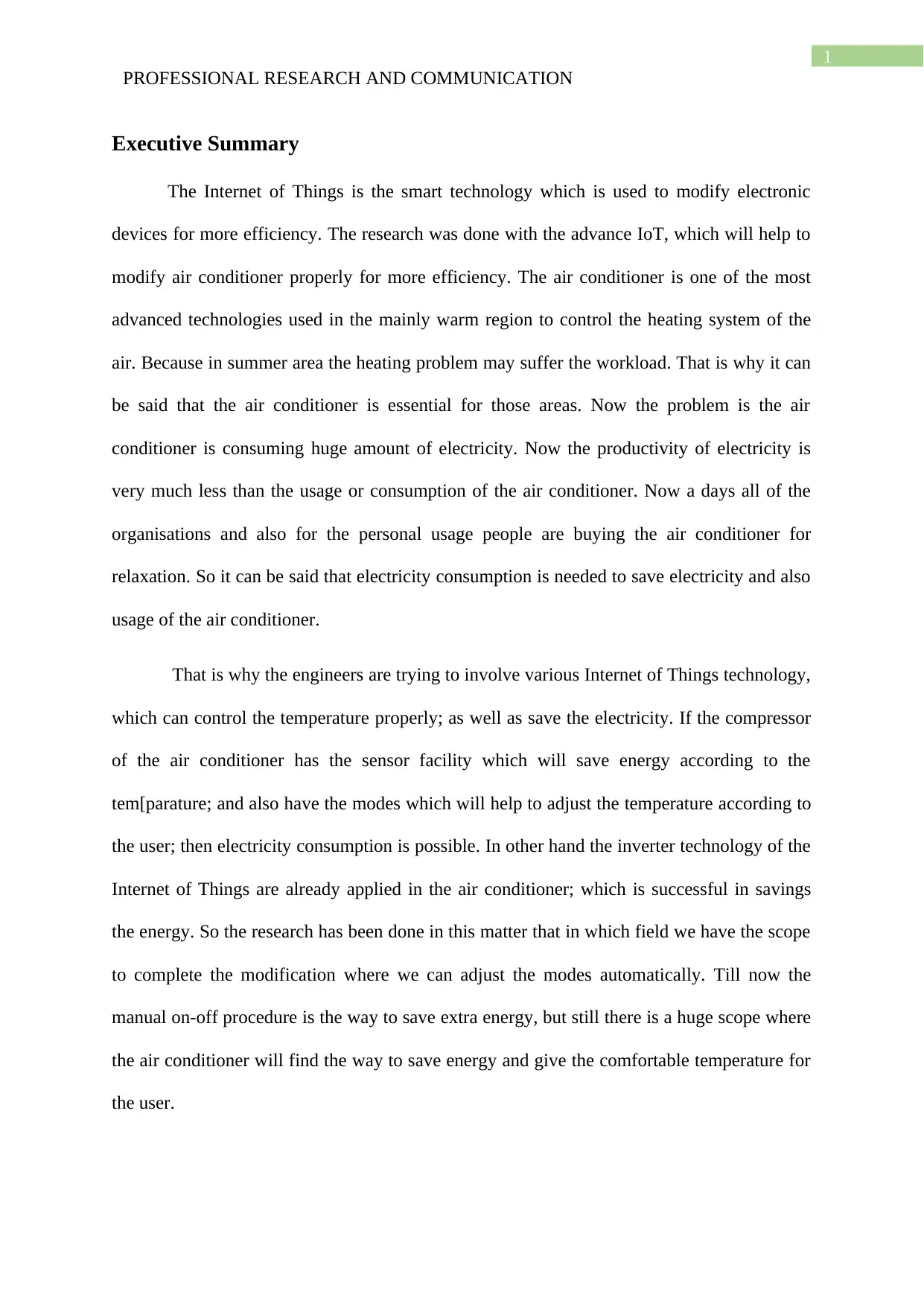
1
PROFESSIONAL RESEARCH AND COMMUNICATION
Executive Summary
The Internet of Things is the smart technology which is used to modify electronic
devices for more efficiency. The research was done with the advance IoT, which will help to
modify air conditioner properly for more efficiency. The air conditioner is one of the most
advanced technologies used in the mainly warm region to control the heating system of the
air. Because in summer area the heating problem may suffer the workload. That is why it can
be said that the air conditioner is essential for those areas. Now the problem is the air
conditioner is consuming huge amount of electricity. Now the productivity of electricity is
very much less than the usage or consumption of the air conditioner. Now a days all of the
organisations and also for the personal usage people are buying the air conditioner for
relaxation. So it can be said that electricity consumption is needed to save electricity and also
usage of the air conditioner.
That is why the engineers are trying to involve various Internet of Things technology,
which can control the temperature properly; as well as save the electricity. If the compressor
of the air conditioner has the sensor facility which will save energy according to the
tem[parature; and also have the modes which will help to adjust the temperature according to
the user; then electricity consumption is possible. In other hand the inverter technology of the
Internet of Things are already applied in the air conditioner; which is successful in savings
the energy. So the research has been done in this matter that in which field we have the scope
to complete the modification where we can adjust the modes automatically. Till now the
manual on-off procedure is the way to save extra energy, but still there is a huge scope where
the air conditioner will find the way to save energy and give the comfortable temperature for
the user.
PROFESSIONAL RESEARCH AND COMMUNICATION
Executive Summary
The Internet of Things is the smart technology which is used to modify electronic
devices for more efficiency. The research was done with the advance IoT, which will help to
modify air conditioner properly for more efficiency. The air conditioner is one of the most
advanced technologies used in the mainly warm region to control the heating system of the
air. Because in summer area the heating problem may suffer the workload. That is why it can
be said that the air conditioner is essential for those areas. Now the problem is the air
conditioner is consuming huge amount of electricity. Now the productivity of electricity is
very much less than the usage or consumption of the air conditioner. Now a days all of the
organisations and also for the personal usage people are buying the air conditioner for
relaxation. So it can be said that electricity consumption is needed to save electricity and also
usage of the air conditioner.
That is why the engineers are trying to involve various Internet of Things technology,
which can control the temperature properly; as well as save the electricity. If the compressor
of the air conditioner has the sensor facility which will save energy according to the
tem[parature; and also have the modes which will help to adjust the temperature according to
the user; then electricity consumption is possible. In other hand the inverter technology of the
Internet of Things are already applied in the air conditioner; which is successful in savings
the energy. So the research has been done in this matter that in which field we have the scope
to complete the modification where we can adjust the modes automatically. Till now the
manual on-off procedure is the way to save extra energy, but still there is a huge scope where
the air conditioner will find the way to save energy and give the comfortable temperature for
the user.
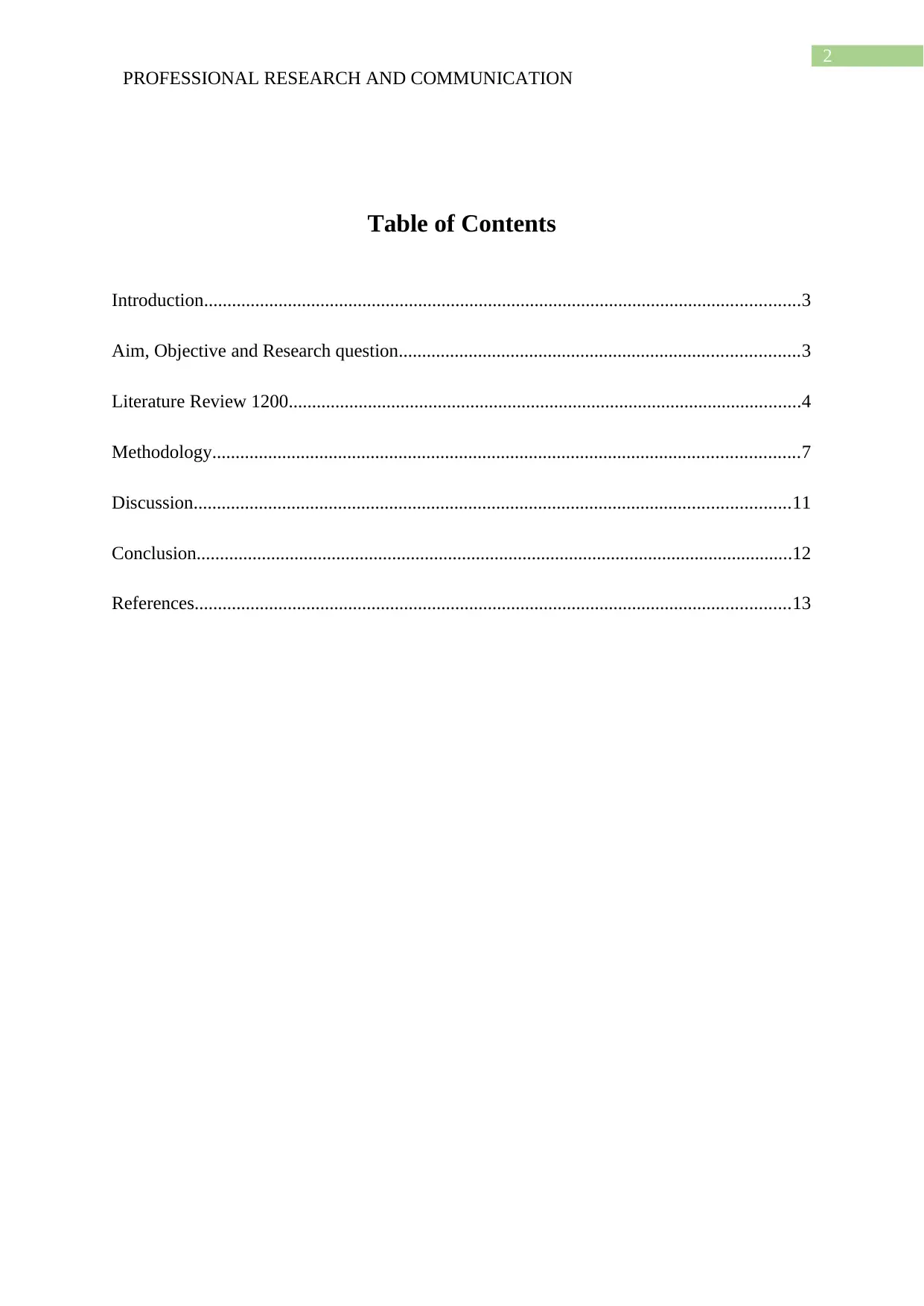
2
PROFESSIONAL RESEARCH AND COMMUNICATION
Table of Contents
Introduction................................................................................................................................3
Aim, Objective and Research question......................................................................................3
Literature Review 1200..............................................................................................................4
Methodology..............................................................................................................................7
Discussion................................................................................................................................11
Conclusion................................................................................................................................12
References................................................................................................................................13
PROFESSIONAL RESEARCH AND COMMUNICATION
Table of Contents
Introduction................................................................................................................................3
Aim, Objective and Research question......................................................................................3
Literature Review 1200..............................................................................................................4
Methodology..............................................................................................................................7
Discussion................................................................................................................................11
Conclusion................................................................................................................................12
References................................................................................................................................13
⊘ This is a preview!⊘
Do you want full access?
Subscribe today to unlock all pages.

Trusted by 1+ million students worldwide

3
PROFESSIONAL RESEARCH AND COMMUNICATION
Introduction
In the growing world of technology, Smart air conditioning is swelling tremendously.
Each day the electric consumption has been raised for the proper usage of the Air conditioner.
For those reasons, the wastage of electricity has been taken places in daily life. That is why it
can be said that electricity consumption is needed. That is why the Internet of Things is
needed to modify the system properly. Various methods are applied to transform the
technology of air conditioning to create proper technology. Air Conditioner has been used in
the commercial and residential both purpose. So if the new technologies can convert the
system low consuming; then an overall huge amount of electricity can be saved. The research
is containing the several methods, technology used in the Air-condition with the help of
Internet of things. There are various methods applied for energy consumption in the Air
Conditioner. These methods are used for the energy efficiency, application control protocol,
auto adjustment of the temperature etc. So it can be said that various methods are applied to
solve this procedure properly. Methods like on-off controlling, smart controlling for decision
parameter, CIOT framework are discussed properly to solve the procedure (Song et al.,2017).
The inverter technology is already used in the Air Conditioner for low consumption.
Sometimes the current consumption has been measured with the star table given by the
company in some countries. The more star rating, it will consume less electricity. So after all
the energy-saving is the main aim of the technology industry, which will help us to provide
proper comfort in less electricity consumption. So the research is containing the proper
research about the topic with the deductive approach (Liu et al.,2016).
PROFESSIONAL RESEARCH AND COMMUNICATION
Introduction
In the growing world of technology, Smart air conditioning is swelling tremendously.
Each day the electric consumption has been raised for the proper usage of the Air conditioner.
For those reasons, the wastage of electricity has been taken places in daily life. That is why it
can be said that electricity consumption is needed. That is why the Internet of Things is
needed to modify the system properly. Various methods are applied to transform the
technology of air conditioning to create proper technology. Air Conditioner has been used in
the commercial and residential both purpose. So if the new technologies can convert the
system low consuming; then an overall huge amount of electricity can be saved. The research
is containing the several methods, technology used in the Air-condition with the help of
Internet of things. There are various methods applied for energy consumption in the Air
Conditioner. These methods are used for the energy efficiency, application control protocol,
auto adjustment of the temperature etc. So it can be said that various methods are applied to
solve this procedure properly. Methods like on-off controlling, smart controlling for decision
parameter, CIOT framework are discussed properly to solve the procedure (Song et al.,2017).
The inverter technology is already used in the Air Conditioner for low consumption.
Sometimes the current consumption has been measured with the star table given by the
company in some countries. The more star rating, it will consume less electricity. So after all
the energy-saving is the main aim of the technology industry, which will help us to provide
proper comfort in less electricity consumption. So the research is containing the proper
research about the topic with the deductive approach (Liu et al.,2016).
Paraphrase This Document
Need a fresh take? Get an instant paraphrase of this document with our AI Paraphraser
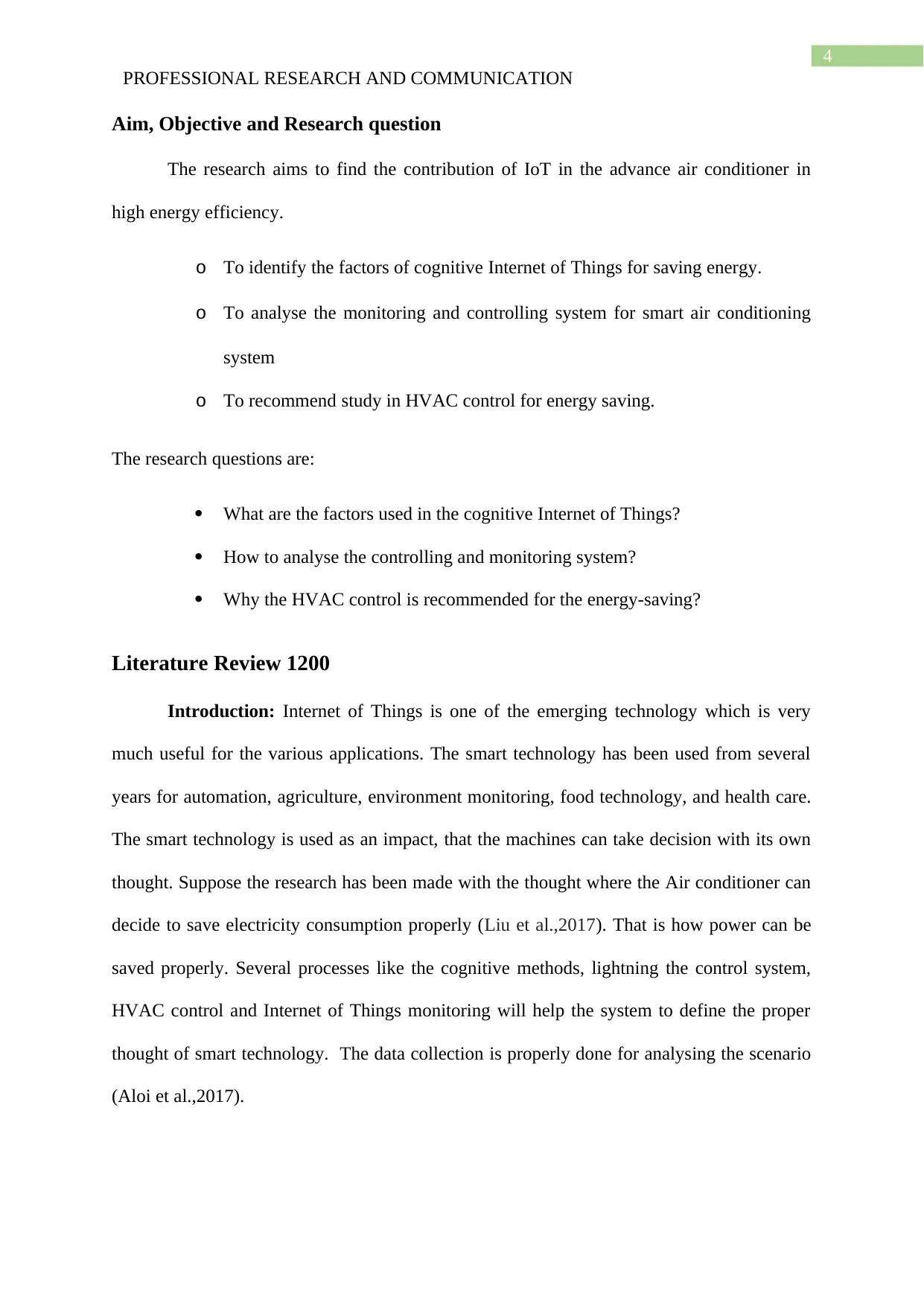
4
PROFESSIONAL RESEARCH AND COMMUNICATION
Aim, Objective and Research question
The research aims to find the contribution of IoT in the advance air conditioner in
high energy efficiency.
o To identify the factors of cognitive Internet of Things for saving energy.
o To analyse the monitoring and controlling system for smart air conditioning
system
o To recommend study in HVAC control for energy saving.
The research questions are:
What are the factors used in the cognitive Internet of Things?
How to analyse the controlling and monitoring system?
Why the HVAC control is recommended for the energy-saving?
Literature Review 1200
Introduction: Internet of Things is one of the emerging technology which is very
much useful for the various applications. The smart technology has been used from several
years for automation, agriculture, environment monitoring, food technology, and health care.
The smart technology is used as an impact, that the machines can take decision with its own
thought. Suppose the research has been made with the thought where the Air conditioner can
decide to save electricity consumption properly (Liu et al.,2017). That is how power can be
saved properly. Several processes like the cognitive methods, lightning the control system,
HVAC control and Internet of Things monitoring will help the system to define the proper
thought of smart technology. The data collection is properly done for analysing the scenario
(Aloi et al.,2017).
PROFESSIONAL RESEARCH AND COMMUNICATION
Aim, Objective and Research question
The research aims to find the contribution of IoT in the advance air conditioner in
high energy efficiency.
o To identify the factors of cognitive Internet of Things for saving energy.
o To analyse the monitoring and controlling system for smart air conditioning
system
o To recommend study in HVAC control for energy saving.
The research questions are:
What are the factors used in the cognitive Internet of Things?
How to analyse the controlling and monitoring system?
Why the HVAC control is recommended for the energy-saving?
Literature Review 1200
Introduction: Internet of Things is one of the emerging technology which is very
much useful for the various applications. The smart technology has been used from several
years for automation, agriculture, environment monitoring, food technology, and health care.
The smart technology is used as an impact, that the machines can take decision with its own
thought. Suppose the research has been made with the thought where the Air conditioner can
decide to save electricity consumption properly (Liu et al.,2017). That is how power can be
saved properly. Several processes like the cognitive methods, lightning the control system,
HVAC control and Internet of Things monitoring will help the system to define the proper
thought of smart technology. The data collection is properly done for analysing the scenario
(Aloi et al.,2017).
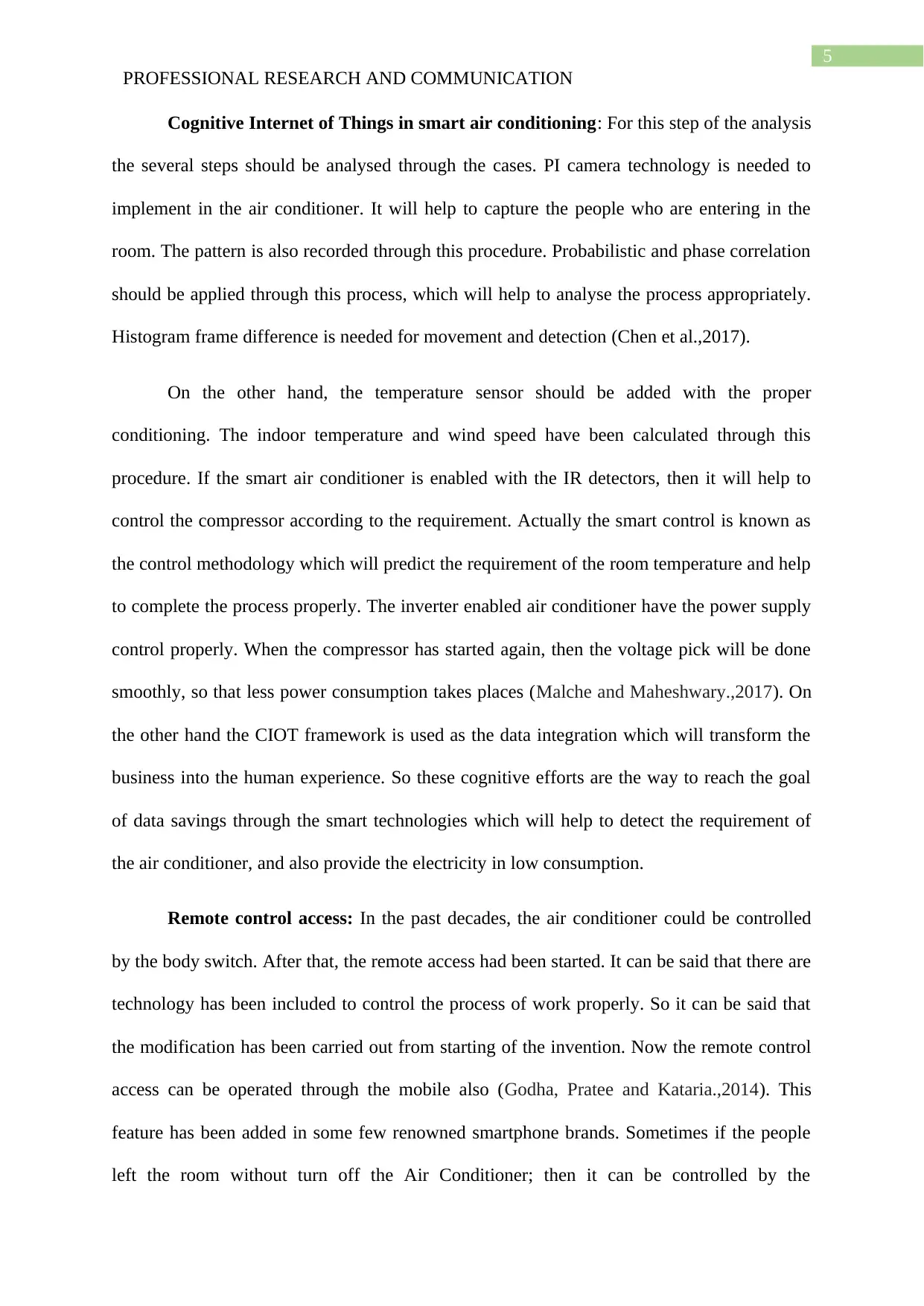
5
PROFESSIONAL RESEARCH AND COMMUNICATION
Cognitive Internet of Things in smart air conditioning: For this step of the analysis
the several steps should be analysed through the cases. PI camera technology is needed to
implement in the air conditioner. It will help to capture the people who are entering in the
room. The pattern is also recorded through this procedure. Probabilistic and phase correlation
should be applied through this process, which will help to analyse the process appropriately.
Histogram frame difference is needed for movement and detection (Chen et al.,2017).
On the other hand, the temperature sensor should be added with the proper
conditioning. The indoor temperature and wind speed have been calculated through this
procedure. If the smart air conditioner is enabled with the IR detectors, then it will help to
control the compressor according to the requirement. Actually the smart control is known as
the control methodology which will predict the requirement of the room temperature and help
to complete the process properly. The inverter enabled air conditioner have the power supply
control properly. When the compressor has started again, then the voltage pick will be done
smoothly, so that less power consumption takes places (Malche and Maheshwary.,2017). On
the other hand the CIOT framework is used as the data integration which will transform the
business into the human experience. So these cognitive efforts are the way to reach the goal
of data savings through the smart technologies which will help to detect the requirement of
the air conditioner, and also provide the electricity in low consumption.
Remote control access: In the past decades, the air conditioner could be controlled
by the body switch. After that, the remote access had been started. It can be said that there are
technology has been included to control the process of work properly. So it can be said that
the modification has been carried out from starting of the invention. Now the remote control
access can be operated through the mobile also (Godha, Pratee and Kataria.,2014). This
feature has been added in some few renowned smartphone brands. Sometimes if the people
left the room without turn off the Air Conditioner; then it can be controlled by the
PROFESSIONAL RESEARCH AND COMMUNICATION
Cognitive Internet of Things in smart air conditioning: For this step of the analysis
the several steps should be analysed through the cases. PI camera technology is needed to
implement in the air conditioner. It will help to capture the people who are entering in the
room. The pattern is also recorded through this procedure. Probabilistic and phase correlation
should be applied through this process, which will help to analyse the process appropriately.
Histogram frame difference is needed for movement and detection (Chen et al.,2017).
On the other hand, the temperature sensor should be added with the proper
conditioning. The indoor temperature and wind speed have been calculated through this
procedure. If the smart air conditioner is enabled with the IR detectors, then it will help to
control the compressor according to the requirement. Actually the smart control is known as
the control methodology which will predict the requirement of the room temperature and help
to complete the process properly. The inverter enabled air conditioner have the power supply
control properly. When the compressor has started again, then the voltage pick will be done
smoothly, so that less power consumption takes places (Malche and Maheshwary.,2017). On
the other hand the CIOT framework is used as the data integration which will transform the
business into the human experience. So these cognitive efforts are the way to reach the goal
of data savings through the smart technologies which will help to detect the requirement of
the air conditioner, and also provide the electricity in low consumption.
Remote control access: In the past decades, the air conditioner could be controlled
by the body switch. After that, the remote access had been started. It can be said that there are
technology has been included to control the process of work properly. So it can be said that
the modification has been carried out from starting of the invention. Now the remote control
access can be operated through the mobile also (Godha, Pratee and Kataria.,2014). This
feature has been added in some few renowned smartphone brands. Sometimes if the people
left the room without turn off the Air Conditioner; then it can be controlled by the
⊘ This is a preview!⊘
Do you want full access?
Subscribe today to unlock all pages.

Trusted by 1+ million students worldwide
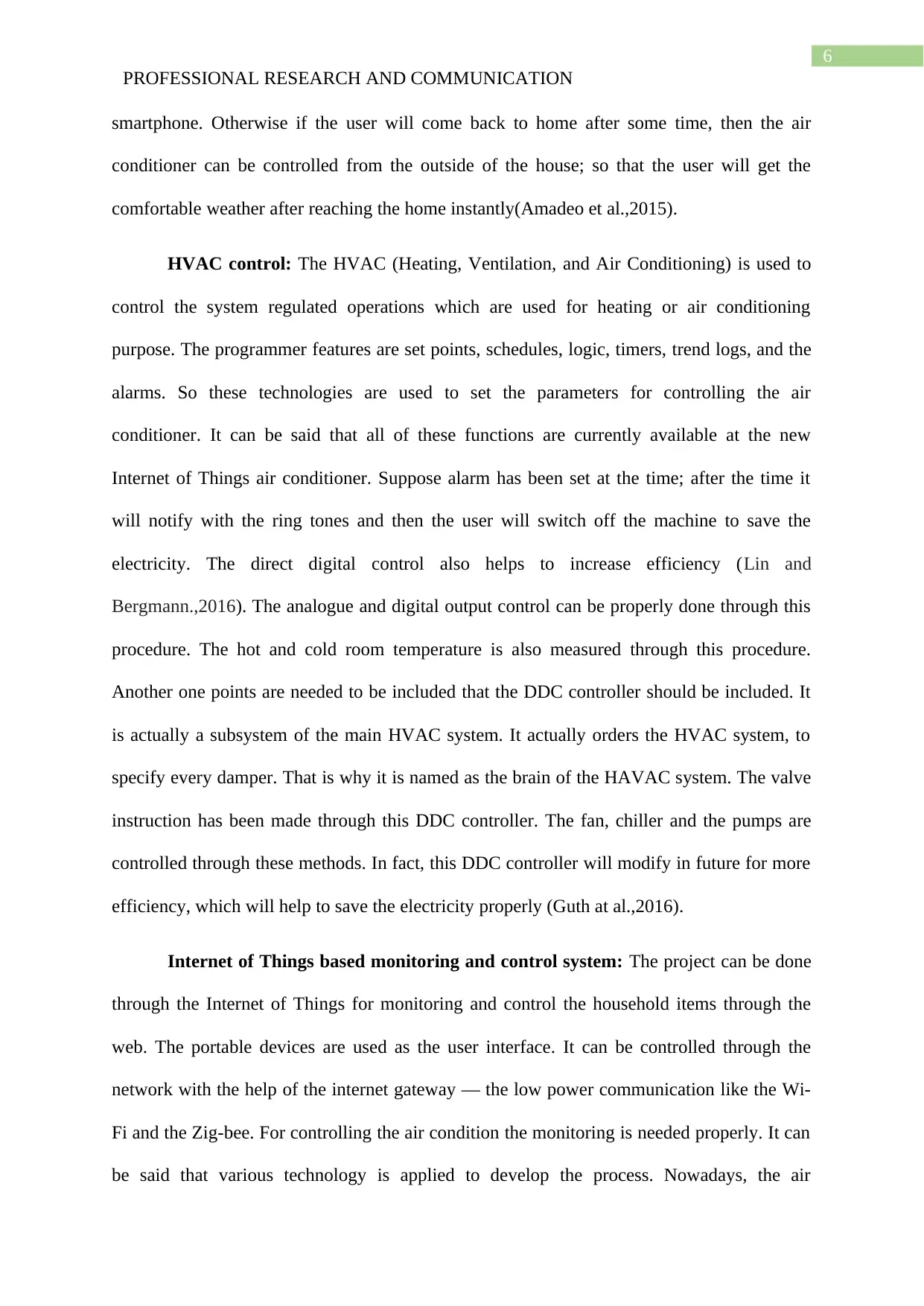
6
PROFESSIONAL RESEARCH AND COMMUNICATION
smartphone. Otherwise if the user will come back to home after some time, then the air
conditioner can be controlled from the outside of the house; so that the user will get the
comfortable weather after reaching the home instantly(Amadeo et al.,2015).
HVAC control: The HVAC (Heating, Ventilation, and Air Conditioning) is used to
control the system regulated operations which are used for heating or air conditioning
purpose. The programmer features are set points, schedules, logic, timers, trend logs, and the
alarms. So these technologies are used to set the parameters for controlling the air
conditioner. It can be said that all of these functions are currently available at the new
Internet of Things air conditioner. Suppose alarm has been set at the time; after the time it
will notify with the ring tones and then the user will switch off the machine to save the
electricity. The direct digital control also helps to increase efficiency (Lin and
Bergmann.,2016). The analogue and digital output control can be properly done through this
procedure. The hot and cold room temperature is also measured through this procedure.
Another one points are needed to be included that the DDC controller should be included. It
is actually a subsystem of the main HVAC system. It actually orders the HVAC system, to
specify every damper. That is why it is named as the brain of the HAVAC system. The valve
instruction has been made through this DDC controller. The fan, chiller and the pumps are
controlled through these methods. In fact, this DDC controller will modify in future for more
efficiency, which will help to save the electricity properly (Guth at al.,2016).
Internet of Things based monitoring and control system: The project can be done
through the Internet of Things for monitoring and control the household items through the
web. The portable devices are used as the user interface. It can be controlled through the
network with the help of the internet gateway — the low power communication like the Wi-
Fi and the Zig-bee. For controlling the air condition the monitoring is needed properly. It can
be said that various technology is applied to develop the process. Nowadays, the air
PROFESSIONAL RESEARCH AND COMMUNICATION
smartphone. Otherwise if the user will come back to home after some time, then the air
conditioner can be controlled from the outside of the house; so that the user will get the
comfortable weather after reaching the home instantly(Amadeo et al.,2015).
HVAC control: The HVAC (Heating, Ventilation, and Air Conditioning) is used to
control the system regulated operations which are used for heating or air conditioning
purpose. The programmer features are set points, schedules, logic, timers, trend logs, and the
alarms. So these technologies are used to set the parameters for controlling the air
conditioner. It can be said that all of these functions are currently available at the new
Internet of Things air conditioner. Suppose alarm has been set at the time; after the time it
will notify with the ring tones and then the user will switch off the machine to save the
electricity. The direct digital control also helps to increase efficiency (Lin and
Bergmann.,2016). The analogue and digital output control can be properly done through this
procedure. The hot and cold room temperature is also measured through this procedure.
Another one points are needed to be included that the DDC controller should be included. It
is actually a subsystem of the main HVAC system. It actually orders the HVAC system, to
specify every damper. That is why it is named as the brain of the HAVAC system. The valve
instruction has been made through this DDC controller. The fan, chiller and the pumps are
controlled through these methods. In fact, this DDC controller will modify in future for more
efficiency, which will help to save the electricity properly (Guth at al.,2016).
Internet of Things based monitoring and control system: The project can be done
through the Internet of Things for monitoring and control the household items through the
web. The portable devices are used as the user interface. It can be controlled through the
network with the help of the internet gateway — the low power communication like the Wi-
Fi and the Zig-bee. For controlling the air condition the monitoring is needed properly. It can
be said that various technology is applied to develop the process. Nowadays, the air
Paraphrase This Document
Need a fresh take? Get an instant paraphrase of this document with our AI Paraphraser
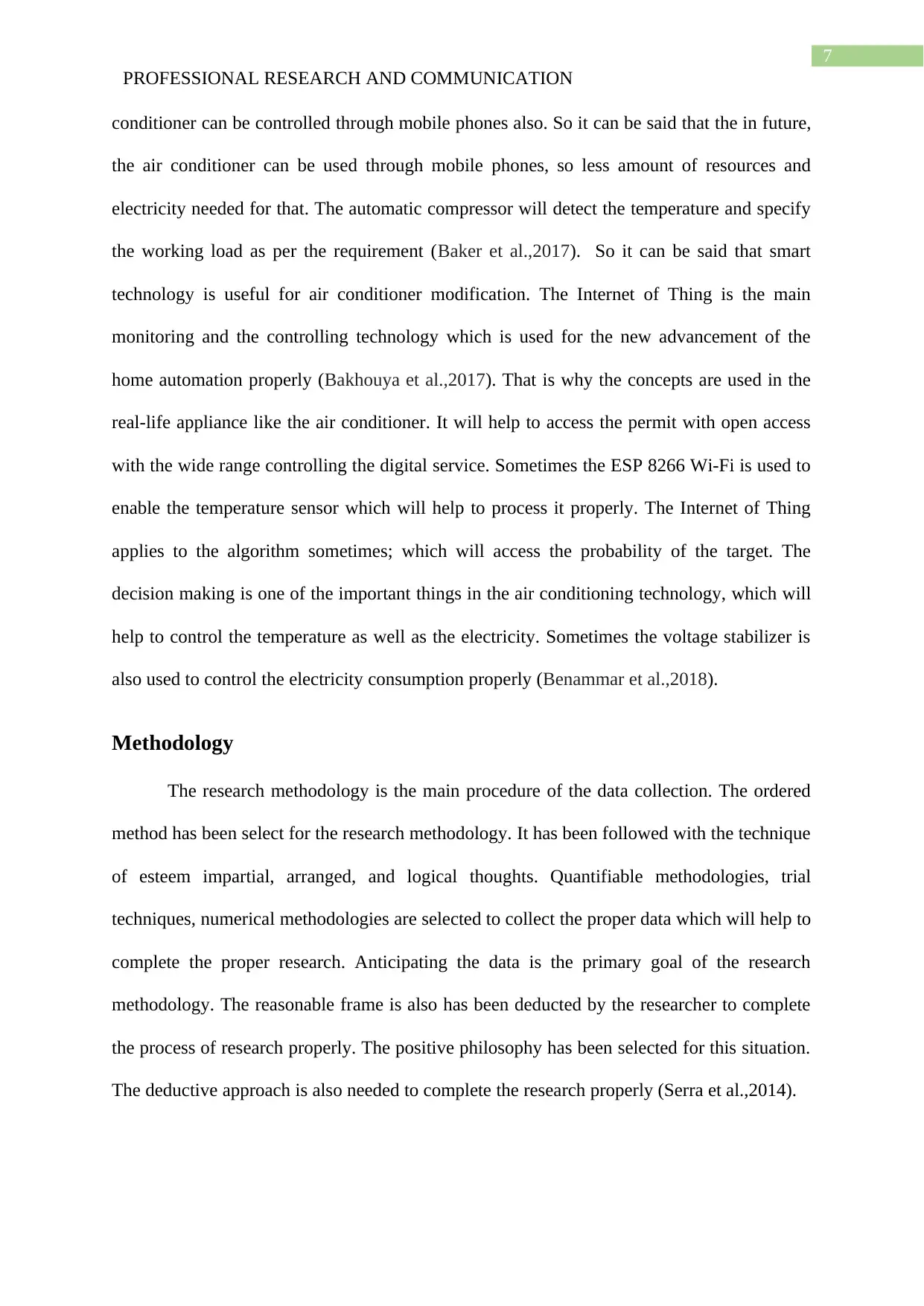
7
PROFESSIONAL RESEARCH AND COMMUNICATION
conditioner can be controlled through mobile phones also. So it can be said that the in future,
the air conditioner can be used through mobile phones, so less amount of resources and
electricity needed for that. The automatic compressor will detect the temperature and specify
the working load as per the requirement (Baker et al.,2017). So it can be said that smart
technology is useful for air conditioner modification. The Internet of Thing is the main
monitoring and the controlling technology which is used for the new advancement of the
home automation properly (Bakhouya et al.,2017). That is why the concepts are used in the
real-life appliance like the air conditioner. It will help to access the permit with open access
with the wide range controlling the digital service. Sometimes the ESP 8266 Wi-Fi is used to
enable the temperature sensor which will help to process it properly. The Internet of Thing
applies to the algorithm sometimes; which will access the probability of the target. The
decision making is one of the important things in the air conditioning technology, which will
help to control the temperature as well as the electricity. Sometimes the voltage stabilizer is
also used to control the electricity consumption properly (Benammar et al.,2018).
Methodology
The research methodology is the main procedure of the data collection. The ordered
method has been select for the research methodology. It has been followed with the technique
of esteem impartial, arranged, and logical thoughts. Quantifiable methodologies, trial
techniques, numerical methodologies are selected to collect the proper data which will help to
complete the proper research. Anticipating the data is the primary goal of the research
methodology. The reasonable frame is also has been deducted by the researcher to complete
the process of research properly. The positive philosophy has been selected for this situation.
The deductive approach is also needed to complete the research properly (Serra et al.,2014).
PROFESSIONAL RESEARCH AND COMMUNICATION
conditioner can be controlled through mobile phones also. So it can be said that the in future,
the air conditioner can be used through mobile phones, so less amount of resources and
electricity needed for that. The automatic compressor will detect the temperature and specify
the working load as per the requirement (Baker et al.,2017). So it can be said that smart
technology is useful for air conditioner modification. The Internet of Thing is the main
monitoring and the controlling technology which is used for the new advancement of the
home automation properly (Bakhouya et al.,2017). That is why the concepts are used in the
real-life appliance like the air conditioner. It will help to access the permit with open access
with the wide range controlling the digital service. Sometimes the ESP 8266 Wi-Fi is used to
enable the temperature sensor which will help to process it properly. The Internet of Thing
applies to the algorithm sometimes; which will access the probability of the target. The
decision making is one of the important things in the air conditioning technology, which will
help to control the temperature as well as the electricity. Sometimes the voltage stabilizer is
also used to control the electricity consumption properly (Benammar et al.,2018).
Methodology
The research methodology is the main procedure of the data collection. The ordered
method has been select for the research methodology. It has been followed with the technique
of esteem impartial, arranged, and logical thoughts. Quantifiable methodologies, trial
techniques, numerical methodologies are selected to collect the proper data which will help to
complete the proper research. Anticipating the data is the primary goal of the research
methodology. The reasonable frame is also has been deducted by the researcher to complete
the process of research properly. The positive philosophy has been selected for this situation.
The deductive approach is also needed to complete the research properly (Serra et al.,2014).
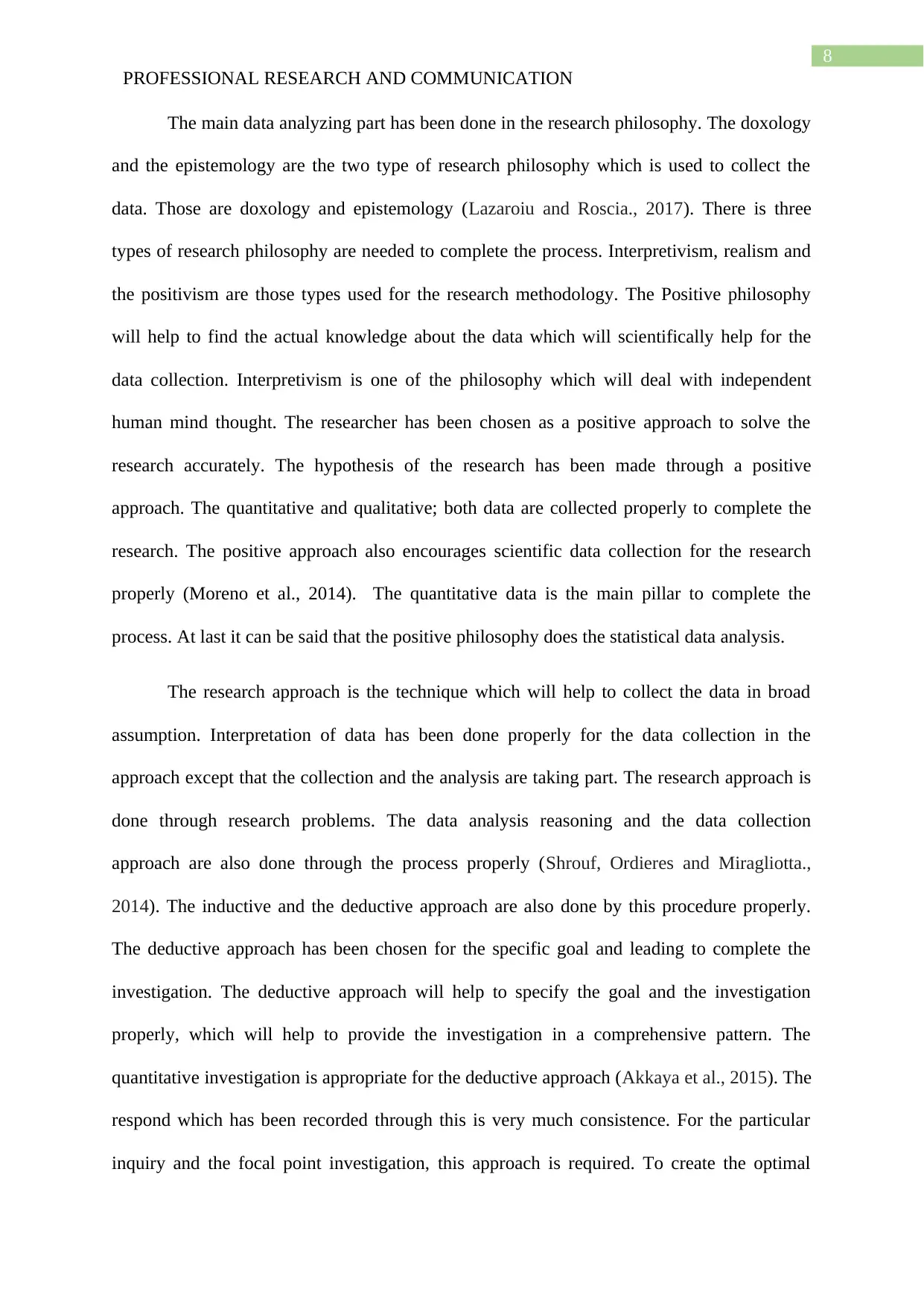
8
PROFESSIONAL RESEARCH AND COMMUNICATION
The main data analyzing part has been done in the research philosophy. The doxology
and the epistemology are the two type of research philosophy which is used to collect the
data. Those are doxology and epistemology (Lazaroiu and Roscia., 2017). There is three
types of research philosophy are needed to complete the process. Interpretivism, realism and
the positivism are those types used for the research methodology. The Positive philosophy
will help to find the actual knowledge about the data which will scientifically help for the
data collection. Interpretivism is one of the philosophy which will deal with independent
human mind thought. The researcher has been chosen as a positive approach to solve the
research accurately. The hypothesis of the research has been made through a positive
approach. The quantitative and qualitative; both data are collected properly to complete the
research. The positive approach also encourages scientific data collection for the research
properly (Moreno et al., 2014). The quantitative data is the main pillar to complete the
process. At last it can be said that the positive philosophy does the statistical data analysis.
The research approach is the technique which will help to collect the data in broad
assumption. Interpretation of data has been done properly for the data collection in the
approach except that the collection and the analysis are taking part. The research approach is
done through research problems. The data analysis reasoning and the data collection
approach are also done through the process properly (Shrouf, Ordieres and Miragliotta.,
2014). The inductive and the deductive approach are also done by this procedure properly.
The deductive approach has been chosen for the specific goal and leading to complete the
investigation. The deductive approach will help to specify the goal and the investigation
properly, which will help to provide the investigation in a comprehensive pattern. The
quantitative investigation is appropriate for the deductive approach (Akkaya et al., 2015). The
respond which has been recorded through this is very much consistence. For the particular
inquiry and the focal point investigation, this approach is required. To create the optimal
PROFESSIONAL RESEARCH AND COMMUNICATION
The main data analyzing part has been done in the research philosophy. The doxology
and the epistemology are the two type of research philosophy which is used to collect the
data. Those are doxology and epistemology (Lazaroiu and Roscia., 2017). There is three
types of research philosophy are needed to complete the process. Interpretivism, realism and
the positivism are those types used for the research methodology. The Positive philosophy
will help to find the actual knowledge about the data which will scientifically help for the
data collection. Interpretivism is one of the philosophy which will deal with independent
human mind thought. The researcher has been chosen as a positive approach to solve the
research accurately. The hypothesis of the research has been made through a positive
approach. The quantitative and qualitative; both data are collected properly to complete the
research. The positive approach also encourages scientific data collection for the research
properly (Moreno et al., 2014). The quantitative data is the main pillar to complete the
process. At last it can be said that the positive philosophy does the statistical data analysis.
The research approach is the technique which will help to collect the data in broad
assumption. Interpretation of data has been done properly for the data collection in the
approach except that the collection and the analysis are taking part. The research approach is
done through research problems. The data analysis reasoning and the data collection
approach are also done through the process properly (Shrouf, Ordieres and Miragliotta.,
2014). The inductive and the deductive approach are also done by this procedure properly.
The deductive approach has been chosen for the specific goal and leading to complete the
investigation. The deductive approach will help to specify the goal and the investigation
properly, which will help to provide the investigation in a comprehensive pattern. The
quantitative investigation is appropriate for the deductive approach (Akkaya et al., 2015). The
respond which has been recorded through this is very much consistence. For the particular
inquiry and the focal point investigation, this approach is required. To create the optimal
⊘ This is a preview!⊘
Do you want full access?
Subscribe today to unlock all pages.

Trusted by 1+ million students worldwide
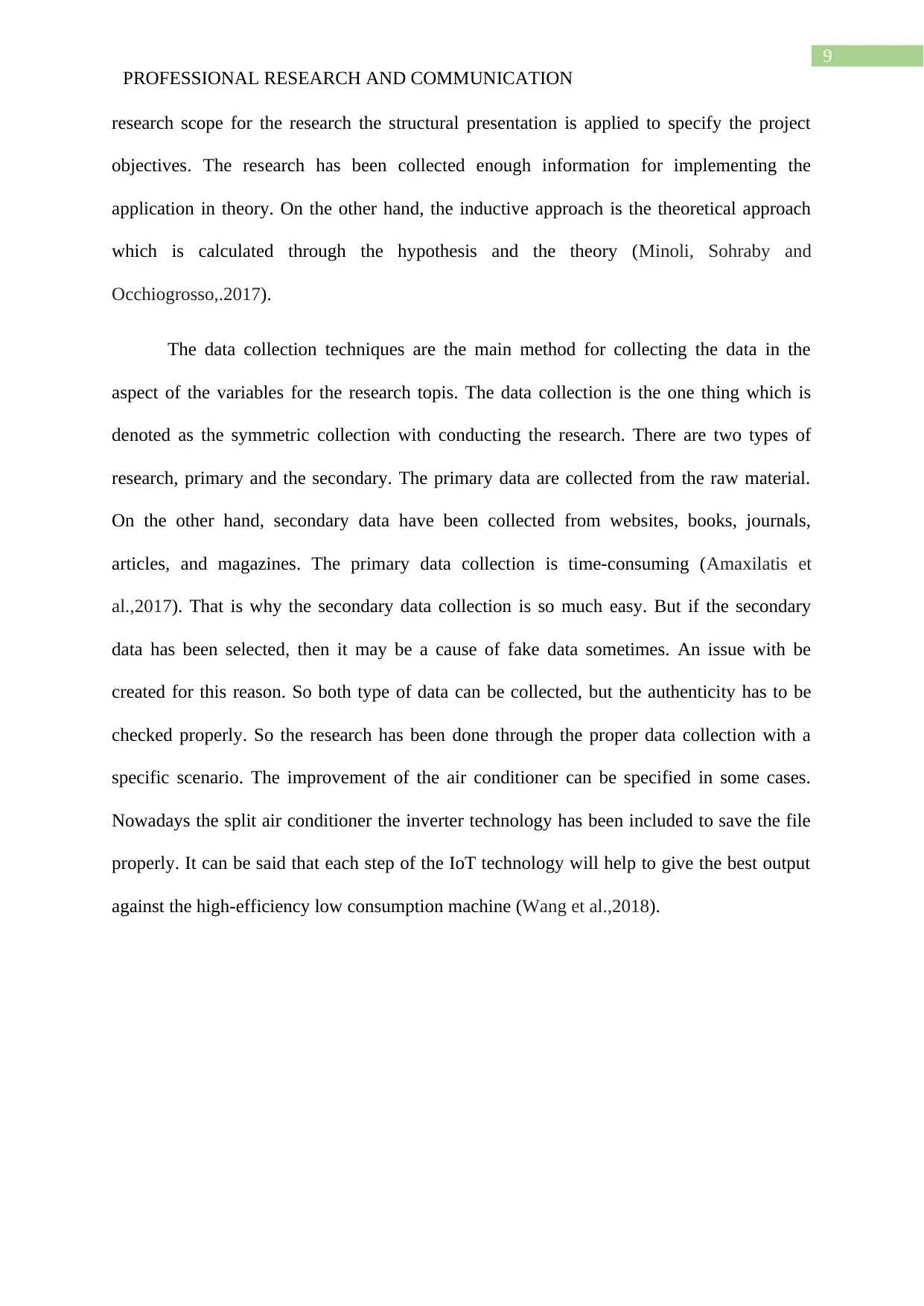
9
PROFESSIONAL RESEARCH AND COMMUNICATION
research scope for the research the structural presentation is applied to specify the project
objectives. The research has been collected enough information for implementing the
application in theory. On the other hand, the inductive approach is the theoretical approach
which is calculated through the hypothesis and the theory (Minoli, Sohraby and
Occhiogrosso,.2017).
The data collection techniques are the main method for collecting the data in the
aspect of the variables for the research topis. The data collection is the one thing which is
denoted as the symmetric collection with conducting the research. There are two types of
research, primary and the secondary. The primary data are collected from the raw material.
On the other hand, secondary data have been collected from websites, books, journals,
articles, and magazines. The primary data collection is time-consuming (Amaxilatis et
al.,2017). That is why the secondary data collection is so much easy. But if the secondary
data has been selected, then it may be a cause of fake data sometimes. An issue with be
created for this reason. So both type of data can be collected, but the authenticity has to be
checked properly. So the research has been done through the proper data collection with a
specific scenario. The improvement of the air conditioner can be specified in some cases.
Nowadays the split air conditioner the inverter technology has been included to save the file
properly. It can be said that each step of the IoT technology will help to give the best output
against the high-efficiency low consumption machine (Wang et al.,2018).
PROFESSIONAL RESEARCH AND COMMUNICATION
research scope for the research the structural presentation is applied to specify the project
objectives. The research has been collected enough information for implementing the
application in theory. On the other hand, the inductive approach is the theoretical approach
which is calculated through the hypothesis and the theory (Minoli, Sohraby and
Occhiogrosso,.2017).
The data collection techniques are the main method for collecting the data in the
aspect of the variables for the research topis. The data collection is the one thing which is
denoted as the symmetric collection with conducting the research. There are two types of
research, primary and the secondary. The primary data are collected from the raw material.
On the other hand, secondary data have been collected from websites, books, journals,
articles, and magazines. The primary data collection is time-consuming (Amaxilatis et
al.,2017). That is why the secondary data collection is so much easy. But if the secondary
data has been selected, then it may be a cause of fake data sometimes. An issue with be
created for this reason. So both type of data can be collected, but the authenticity has to be
checked properly. So the research has been done through the proper data collection with a
specific scenario. The improvement of the air conditioner can be specified in some cases.
Nowadays the split air conditioner the inverter technology has been included to save the file
properly. It can be said that each step of the IoT technology will help to give the best output
against the high-efficiency low consumption machine (Wang et al.,2018).
Paraphrase This Document
Need a fresh take? Get an instant paraphrase of this document with our AI Paraphraser
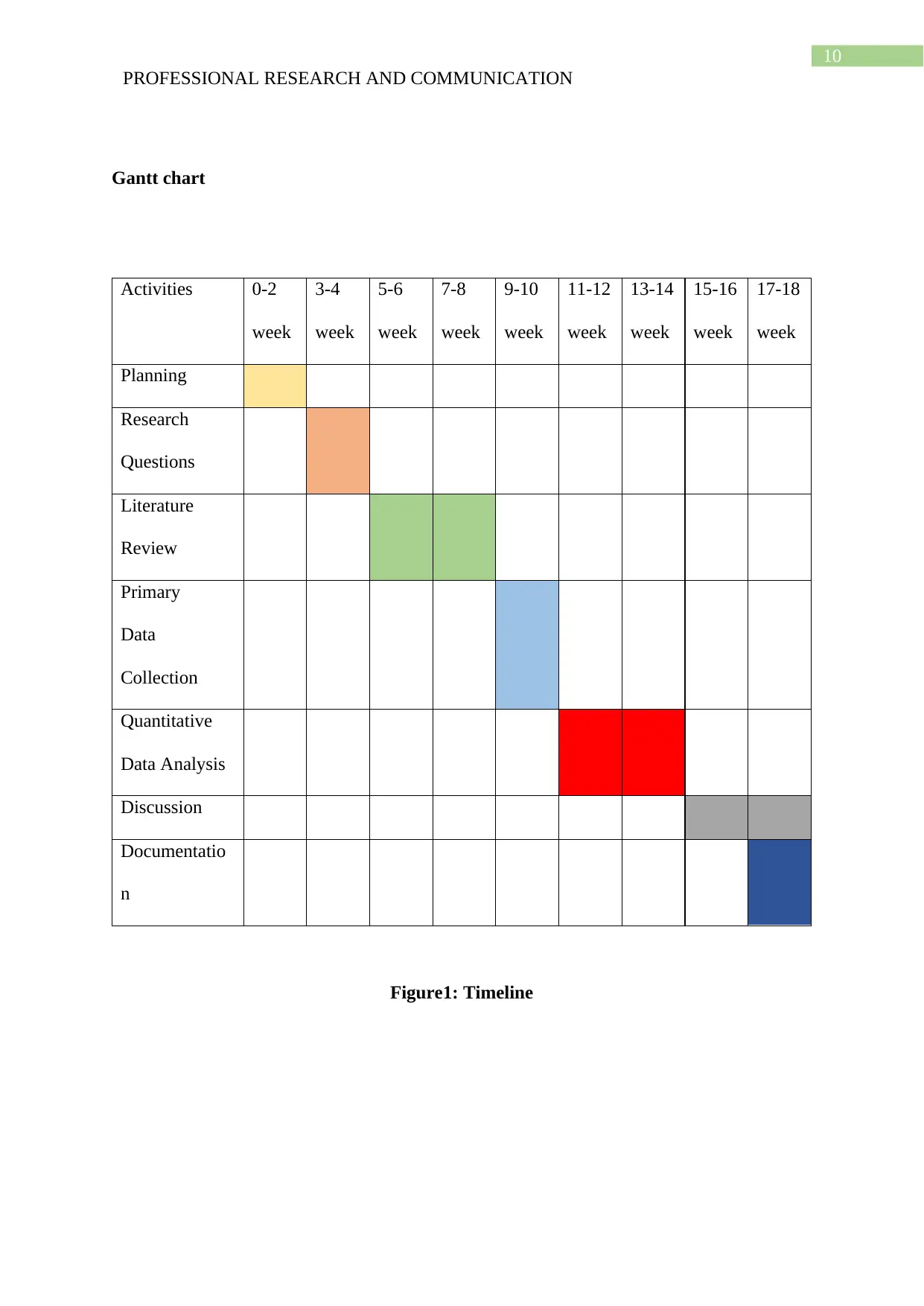
10
PROFESSIONAL RESEARCH AND COMMUNICATION
Gantt chart
Activities 0-2
week
3-4
week
5-6
week
7-8
week
9-10
week
11-12
week
13-14
week
15-16
week
17-18
week
Planning
Research
Questions
Literature
Review
Primary
Data
Collection
Quantitative
Data Analysis
Discussion
Documentatio
n
Figure1: Timeline
PROFESSIONAL RESEARCH AND COMMUNICATION
Gantt chart
Activities 0-2
week
3-4
week
5-6
week
7-8
week
9-10
week
11-12
week
13-14
week
15-16
week
17-18
week
Planning
Research
Questions
Literature
Review
Primary
Data
Collection
Quantitative
Data Analysis
Discussion
Documentatio
n
Figure1: Timeline
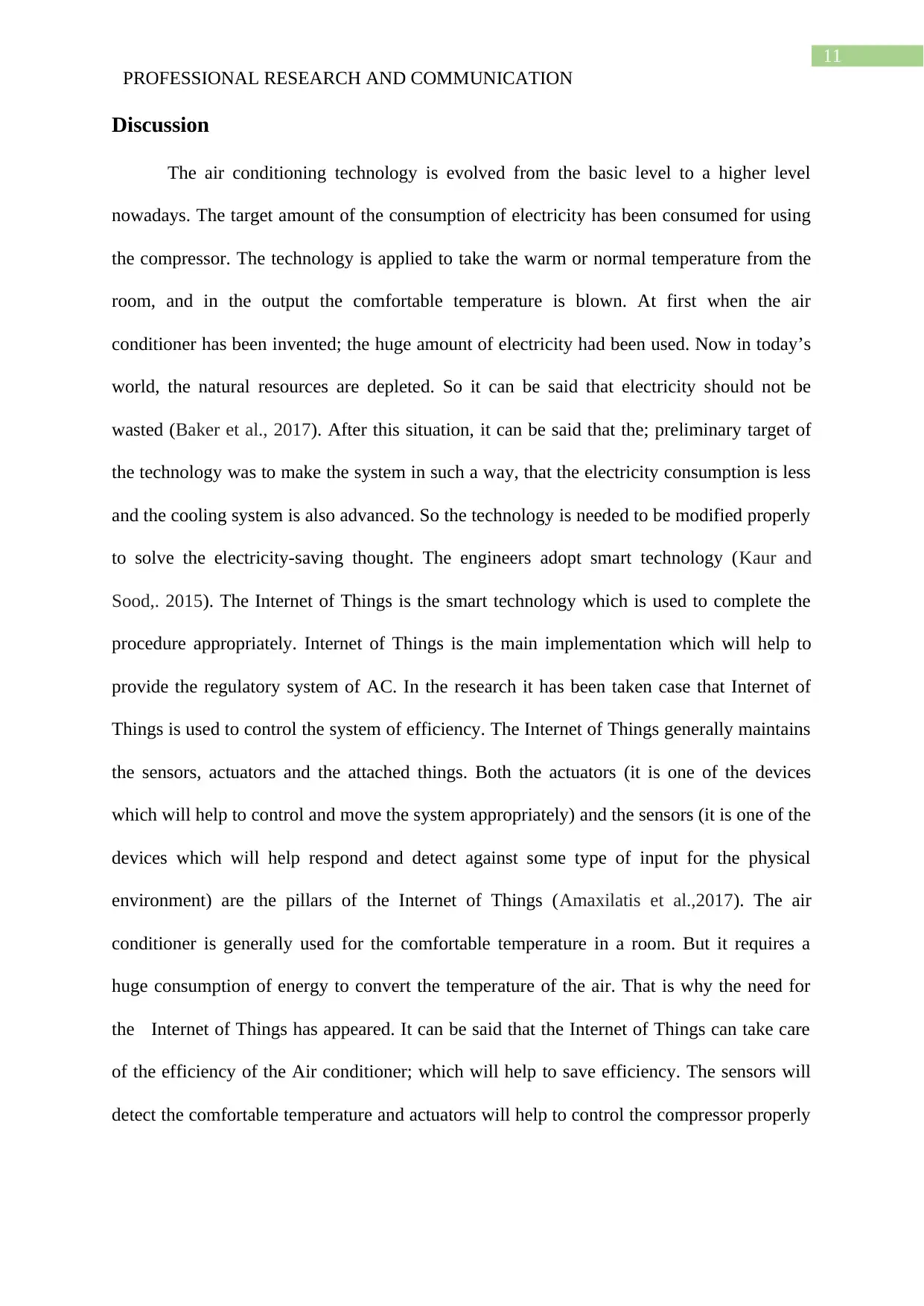
11
PROFESSIONAL RESEARCH AND COMMUNICATION
Discussion
The air conditioning technology is evolved from the basic level to a higher level
nowadays. The target amount of the consumption of electricity has been consumed for using
the compressor. The technology is applied to take the warm or normal temperature from the
room, and in the output the comfortable temperature is blown. At first when the air
conditioner has been invented; the huge amount of electricity had been used. Now in today’s
world, the natural resources are depleted. So it can be said that electricity should not be
wasted (Baker et al., 2017). After this situation, it can be said that the; preliminary target of
the technology was to make the system in such a way, that the electricity consumption is less
and the cooling system is also advanced. So the technology is needed to be modified properly
to solve the electricity-saving thought. The engineers adopt smart technology (Kaur and
Sood,. 2015). The Internet of Things is the smart technology which is used to complete the
procedure appropriately. Internet of Things is the main implementation which will help to
provide the regulatory system of AC. In the research it has been taken case that Internet of
Things is used to control the system of efficiency. The Internet of Things generally maintains
the sensors, actuators and the attached things. Both the actuators (it is one of the devices
which will help to control and move the system appropriately) and the sensors (it is one of the
devices which will help respond and detect against some type of input for the physical
environment) are the pillars of the Internet of Things (Amaxilatis et al.,2017). The air
conditioner is generally used for the comfortable temperature in a room. But it requires a
huge consumption of energy to convert the temperature of the air. That is why the need for
the Internet of Things has appeared. It can be said that the Internet of Things can take care
of the efficiency of the Air conditioner; which will help to save efficiency. The sensors will
detect the comfortable temperature and actuators will help to control the compressor properly
PROFESSIONAL RESEARCH AND COMMUNICATION
Discussion
The air conditioning technology is evolved from the basic level to a higher level
nowadays. The target amount of the consumption of electricity has been consumed for using
the compressor. The technology is applied to take the warm or normal temperature from the
room, and in the output the comfortable temperature is blown. At first when the air
conditioner has been invented; the huge amount of electricity had been used. Now in today’s
world, the natural resources are depleted. So it can be said that electricity should not be
wasted (Baker et al., 2017). After this situation, it can be said that the; preliminary target of
the technology was to make the system in such a way, that the electricity consumption is less
and the cooling system is also advanced. So the technology is needed to be modified properly
to solve the electricity-saving thought. The engineers adopt smart technology (Kaur and
Sood,. 2015). The Internet of Things is the smart technology which is used to complete the
procedure appropriately. Internet of Things is the main implementation which will help to
provide the regulatory system of AC. In the research it has been taken case that Internet of
Things is used to control the system of efficiency. The Internet of Things generally maintains
the sensors, actuators and the attached things. Both the actuators (it is one of the devices
which will help to control and move the system appropriately) and the sensors (it is one of the
devices which will help respond and detect against some type of input for the physical
environment) are the pillars of the Internet of Things (Amaxilatis et al.,2017). The air
conditioner is generally used for the comfortable temperature in a room. But it requires a
huge consumption of energy to convert the temperature of the air. That is why the need for
the Internet of Things has appeared. It can be said that the Internet of Things can take care
of the efficiency of the Air conditioner; which will help to save efficiency. The sensors will
detect the comfortable temperature and actuators will help to control the compressor properly
⊘ This is a preview!⊘
Do you want full access?
Subscribe today to unlock all pages.

Trusted by 1+ million students worldwide
1 out of 17
Related Documents
Your All-in-One AI-Powered Toolkit for Academic Success.
+13062052269
info@desklib.com
Available 24*7 on WhatsApp / Email
![[object Object]](/_next/static/media/star-bottom.7253800d.svg)
Unlock your academic potential
Copyright © 2020–2025 A2Z Services. All Rights Reserved. Developed and managed by ZUCOL.





